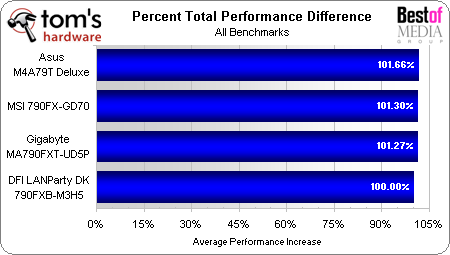Roundup: Four 790FX Socket AM3 Motherboards
Conclusion
Average performance is a key factor in many purchasing decisions, although we take a more balanced approach.
Asus has clear performance leadership, but is it the best motherboard choice? Let’s consider our options.
With a performance “disadvantage” of less than one-half percent, the MSI 790FX-GD70 provided superior graphics card slot spacing and overclocking compared to the M4A79T Deluxe. MSI’s motherboard is also slightly less expensive and includes several added features, such as dual-Gigabit LAN and support for three more SATA devices.
But both Asus and MSI have some trouble in the area of cable header placement, with audio and FireWire connections in the lower-rear corner that are nearly impossible to reach with the cables of top-panel ports. Additionally, both companies have neglected the stubborn Windows XP market for which floppy drives are occasionally useful, by putting the floppy header beneath the lowest expansion slot.
With a performance deficit of less than a tenth of one percent compared to MSI, the Gigabyte GA-MA790FXT-UD5P also had the highest CPU overclock and the best cable header layout. The only disadvantage is its use of only two PCIe x16 slots, but the remaining slots don’t steal any pathways from the x16 slots. Thus, it could be a better board for anyone considering one or two dual-GPU graphics cards, rather than three or four single-GPU units.
Finally there’s the DFI LANParty DK 790FXB-M3H5, which is nearly average in every way except price–it’s around 20% cheaper than other 790FX Socket AM3 solutions, and could be the basis for a reduced-cost gaming system.
MSI’s best-in-class features make the 790FX-GD70 a top value among the three most expensive boards, but most of our editors would probably choose the Gigabyte MA790FXT-UD5P for its cable header placement.
Get Tom's Hardware's best news and in-depth reviews, straight to your inbox.
-
NitroSuperSonic AMD Phenom II X3 720 Black EditionReply
(2.80 GHz, 86.0 MB Cache)
I never knew any AMD processors had that much cache! -
judeh101 NitroSuperSonicAMD Phenom II X3 720 Black Edition(2.80 GHz, 86.0 MB Cache)I never knew any AMD processors had that much cache!Reply
Super CPU! -
ifko_pifko "Asus has clear performance leadership,..." :-)))Reply
1.66% better than the worst performer in the tests. :-) -
tacoslave who said Phenom II has low cache size i think with those 86mb you can do amazing things!!Reply -
tacoslave sorry about the double post but i would have liked to have seen these benchmarked with two 4870x2's... since they keep talking about them so much.Reply -
cangelini Super CPU fixed ;)Reply
Not much point in throwing that much GPU horsepower at a motherboard review; the card Thomas used is our current reference--and it's more than ample for showcasing the differences between these boards.
If you want to see quad-CrossFire for any specific reason, feel free to let us know and we can put together a story idea! -
EQPlayer I think people would like to see a dual-295/dual-4870x2 series of benches if only for the "OMG BEASTLY!" factor. I dunno. XDReply -
Crashman ifko_pifko"Asus has clear performance leadership,..." :-)))1.66% better than the worst performer in the tests. :-)Reply
Consistent would have been better if not for the fear of people pointing out ever tiny inconsistency. Just remember, if you're 5'11" tall it's clear to just about everyone that you're not 6'!!! -
Proximon cangelini...the card Thomas used is our current reference--and it's more than ample for showcasing the differences between these boards.Reply
Could you clarify that a bit Chris? Are you saying you would not expect any difference in crossfire between the MBs? If so, that's OK. However, if there's going to be a difference, that is the main reason to buy a 790FX. If you aren't going to crossfire might as well get a GX.
I suspect the chipset isn't the whole story and the various manufacturers could still screw up the PCI-E voltages or something :p

